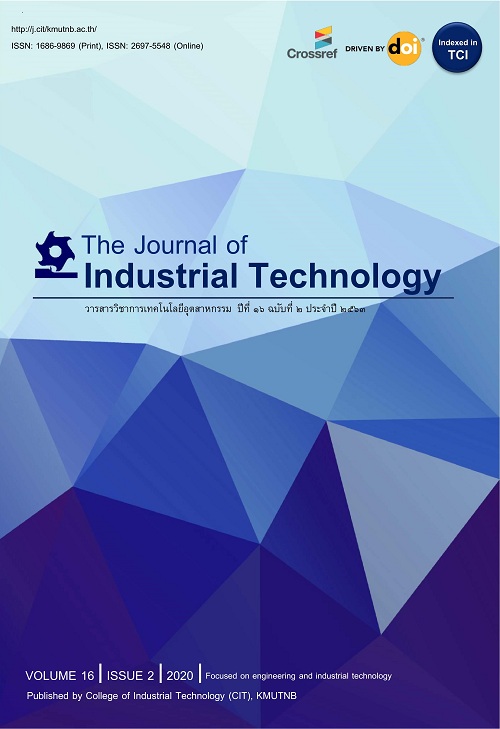The Study of the Effect of O2 Contamination on Discoloration at Root Pass Welding of Titanium Grade 2 Pipe ASTM B 861 Using Gas Tungsten Arc Welding
Abstract
การศึกษานี้ตรวจสอบการเปลี่ยนสีผิวของท่อไทเทเนียมจากการเชื่อมด้วยกระบวนการเชื่อมอาร์กทังสเตนแก๊สคลุม (GTAW) โดยใช้มาตรฐาน NORSOK M601:2016 เป็นแนวทางตรวจสอบ โดยการวิจัยนี้มุ่งเน้นไปที่ความแม่นยำของการตรวจสอบด้วยวิธีตรวจพินิจ โดยการใช้กล้องงูเพื่อตรวจสอบรอยเชื่อมรากภายในท่อ วัตถุประสงค์หลักเพื่อสร้างตารางอ้างอิงมาตรฐานสำหรับการประเมินการเปลี่ยนสีของท่อไทเทเนียมที่รอยเชื่อมรากด้านในท่อ โดยพิจารณาจากการตรวจสอบด้วยสายตาทั้งแบบใช้และไม่ใช้กล้องงู กำหนดกระบวนการเชื่อมอาร์กทังสเตนแก๊สคลุมภายใต้สภาวะความเข้มข้นของออกซิเจนในบรรยากาศอาร์กอนที่ 50, 100, 300, และ 700 ส่วนในล้านส่วน (ppm) นอกจากนี้ยังควบคุมความเร็วในการเชื่อมเพื่อเปรียบเทียบผลกระทบจากความแตกต่างของค่าความร้อนเข้าสู่ชิ้นงาน เปรียบเทียบภาพที่ได้จากภายในท่อโดยการใช้กล้องส่องงูกับภาพของแนวเชื่อมด้านในท่อจากการตัดตามยาว ผลการวิจัยพบว่าภาพจากกล้องงูมีสีเข้มกว่าแต่ไม่ส่งผลกระทบต่อการตีความ ที่ความเข้มข้นของออกซิเจนที่เกินกว่า 100 ppm บริเวณรอยเชื่อมแนวรากมีการเปลี่ยนสีผิวอย่างมีนัยสำคัญ ส่งผลให้ไม่เหมาะสมสำหรับการใช้งานในทุกความเร็วการเชื่อม
This study investigates the discoloration of as-welded titanium pipes using gas tungsten arc welding (GTAW) in accordance with the NORSOK standard M601:2016, which provides guidelines for welding and inspecting titanium piping. A key focus of this research centers on the precision of visual inspections, particularly when employing a borescope to examine the root weld within the pipe. The principal objective is to establish a standardized reference table for evaluating the discoloration of as-welded titanium pipes at the root, considering both visual inspections conducted with and without a borescope. The GTAW process was conducted under controlled conditions by deliberate manipulation of oxygen concentration in the Argon atmosphere, ranging from 50, 100, 300, to 700 parts per million (ppm). Furthermore, travel speed was regulated to create variations in heat input. A comparative analysis was conducted, contrasting images obtained inside the pipe using a borescope with images of the root after a lengthwise cut. The findings reveal that the images captured through the borescope exhibit darker shading; however, this divergence does not compromise the quality of interpretation. Notably, oxygen concentrations exceeding 100 ppm led to significant discoloration, rendering the material unsuitable for use at any travel speed.
Keywords
[1] I.V. Gorynin, Titanium alloys for marine application, Materials Science and Engineering, 1999, 263(2), 112-116.
[2] D.A. Shifler, Marine and offshore piping systems, LaQue's Handbook of Marine Corrosion, 2002, 667-689.
[3] S. Min, S. An, J. Park, Y. Park and N. Kang, Effects of GTAW pulse condition on penetration, discoloration and bending property for titanium tube, Journal of Welding and Joining, 2014, 32(6), 583-591.
[4] R.W. Erskine, Design, fabrication, installation, and operation of titanium seawater piping systems, Journal of Ship Production, 1997, 13(04), 270-289.
[5] NORSOK Standard M-601: Welding and Inspection of Piping, 2016.
[6] S. Lathabai, B.L. Jarvis and K.J. Barton, Comparison of keyhole and conventional gas tungsten arc welds in commercially pure titanium, Materials Science and Engineering, 2001, 299(1-2), 81-93.
[7] WPS No. P141-Ti-03, IBEL Thailand, 2019.
[8] ASME BPVC Section ll Part B, Nonferrous Material Specification, 2019.
[9] ASTM E407-99, Standard Practice for Microetching Metals and Alloys, 1999.
[10] BS EN1011-1, Welding Recommendations for Welding of Metallic Materials, Part 1: General Guidance for Arc Welding, 1998.
[11] Metallography and microstructures, ASM handbook, ASM International, MI, USA, 1985.
[12] G. Lutjering, J.C. Williams, and A. Gysler, Microstructure and mechanical properties of titanium alloys, Lawrence Berkeley National Laboratory, CA, USA, 2003, 6-10.
DOI: 10.14416/j.ind.tech.2024.08.011
Refbacks
- There are currently no refbacks.






